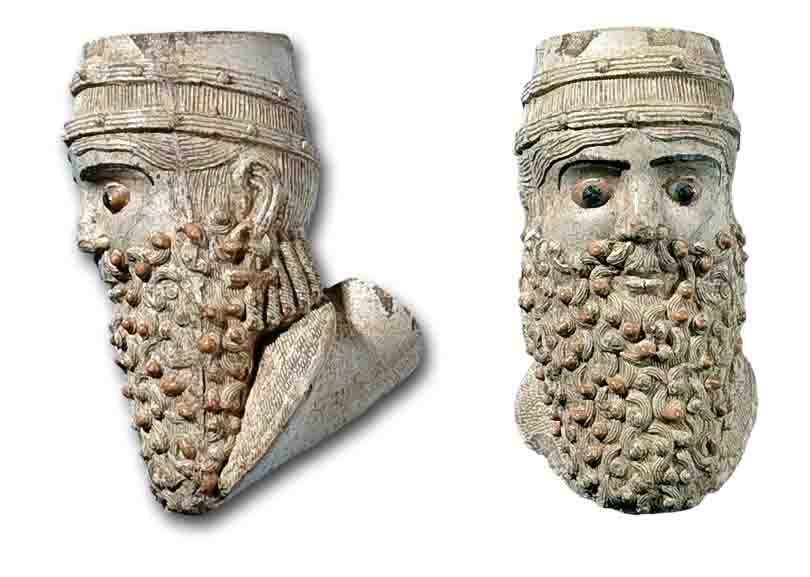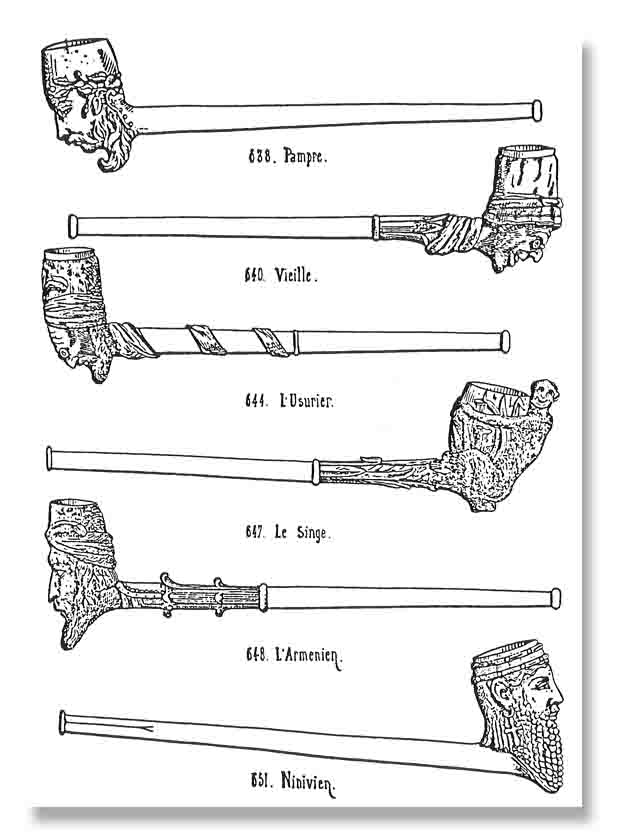 |
|||||
 |
|||||
ARCHAEOLOGY OF SPRINGFIELD
INTRODUCTION TO SPRINGFIELD ARCHAEOLOGY
SPRINGFIELDS’S HISTORIC LANDSCAPE
SPRINGFIELD HOUSE FROM THE RIVERFRONT AUGUSTA ARCHAEOLOGY STUDY
LIFE IN ANTEBELLUM SPRINGFIELD
CHANGE AND DIVERSITY IN POST-WAR SPRINGFIELD
THE NINIVIEN PIPE: A SYMBOL OF HOPE AND FREEDOM
AFRICAN AMERICAN ARCHAEOLOGY IN GEORGIA
|
Molded Clay Tobacco Pipe in “Ninivien” Style. The pipe design copies archaeological discoveries made in Mesopotamia during the 1840s. (Source: New South Associates, Inc.).
Illustration from Nineveh and Its Remains by Henry Layard (published 1849) Showing Statuary Similar to the Ninevien Pipe Design. (Source: Layard 1849).
A Page from the French Pipe Maker Gambier’s Catalog. Design 651 (bottom) shows a style matching the pipe found at the Riverfront Augusta Site.
|
THE NINIVIEN PIPE: A SYMBOL OF HOPE AND FREEDOM? Among the artifacts from the Riverfront Augusta Site was a unique tobacco pipe that might express certain attitudes of African Americans before the Civil War. This pipe was found in the remains of a house that was almost certainly occupied by African Americans. The pipe was lost or discarded during the 1850s. The clay pipe bowl found at the Riverfront Augusta Site was clearly modeled after ancient Assyrian art and closely resembling statues uncovered in Mesopotamia during the 1840s and 1850s. A nineteenth-century pipe maker's catalog illustrates this design as 'Ninevien', which indicates it was directly inspired by archaeological discoveries of the time. Nineveh was the ancient capital of the Assyrian Empire, which lasted between around 900 and 600 B.C. It was also mentioned in the Old Testament as an adversary of the Israelites as well as being named in the prophecies of both Jonah and Nahum. The discovery of these ancient Assyrian cities had important implications for Christianity during the nineteenth century because it was seen as proof of the Bible’s historical accuracy. The finds were widely known and discussed, helping to fuel the Evangelical movement during the nineteenth century. So what is the importance of finding the Ninevien pipe in the remains of an antebellum house in Augusta? Pipes were used as symbols of social status in Africa and they were also used to display status in the southeastern United States. An 1802 Augusta city ordnance prohibited enslaved and free African Americans from smoking a pipe or cigar in public, noting that such "privileges" were reserved for European-Americans. Thus, this pipe could have belonged to an important member of the Springfield Community, one who may not have used the pipe in public settings. The Ninevien pipe might have had symbolic meanings beyond its obvious purpose. There are two possible interpretations of this artifact’s meaning relating to its biblical references and to its presence in an African American household in a slave society. The first possibility has to do with Jonah’s prediction of the destruction of Nineveh. The story portrays God as merciful and willing to forgive man’s sins. In the context of antebellum southern society, which was based on unequal and brutal social relationships, there was a need to believe that God is just, loving, and compassionate. In this context, Nineveh can be viewed as a symbol of God’s deliverance of man and of the prospect of redemption. A second possible interpretation is that the pipe references the Old Testament prophecy of Nahum, a prophet who described the destruction of Nineveh around 611 B.C. Nahum’s story presents God coming to the rescue of enslaved and oppressed people, while punishing their enslavers at the same time. African Americans might have looked at this story as an allegory of the justice that would be meted on European-American southerners. The archaeological discovery of Nineveh would have been especially encouraging to southern African Americans, who may have found hope in the words of the Old Testament's Prophecy of Nahum:
One of the important contributions of archaeological research is that it can provide insights into the attitudes and beliefs of people who could not or did not record them. What African American thought about slavery is largely unknown from their own words. The discovery of the Ninevien pipe hints at aspects of their culture, attitudes, and beliefs that might not be known otherwise. This object also illustrates some of the multiple functions---practical and symbolic—that objects can acquire in specific historical contexts. Itinerant Preacher in Augusta, Early Twentieth Century. (Source: Augusta Museum of History). |



